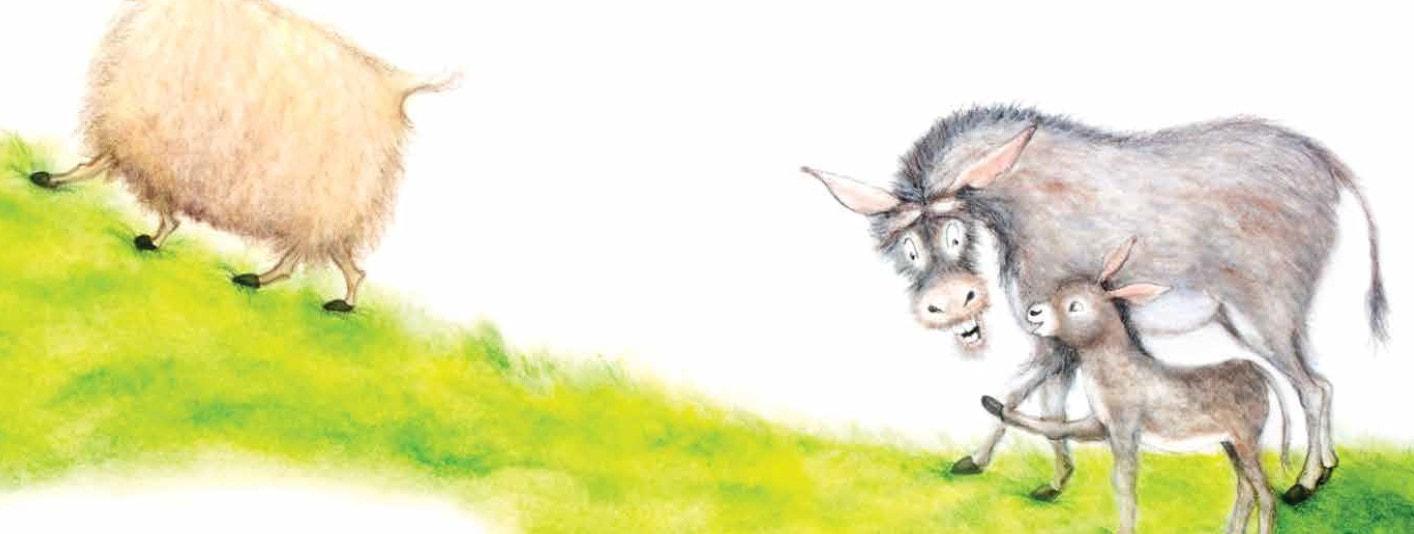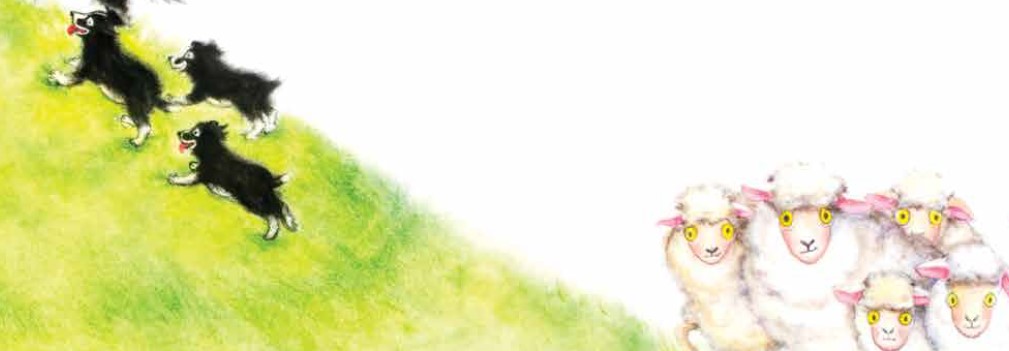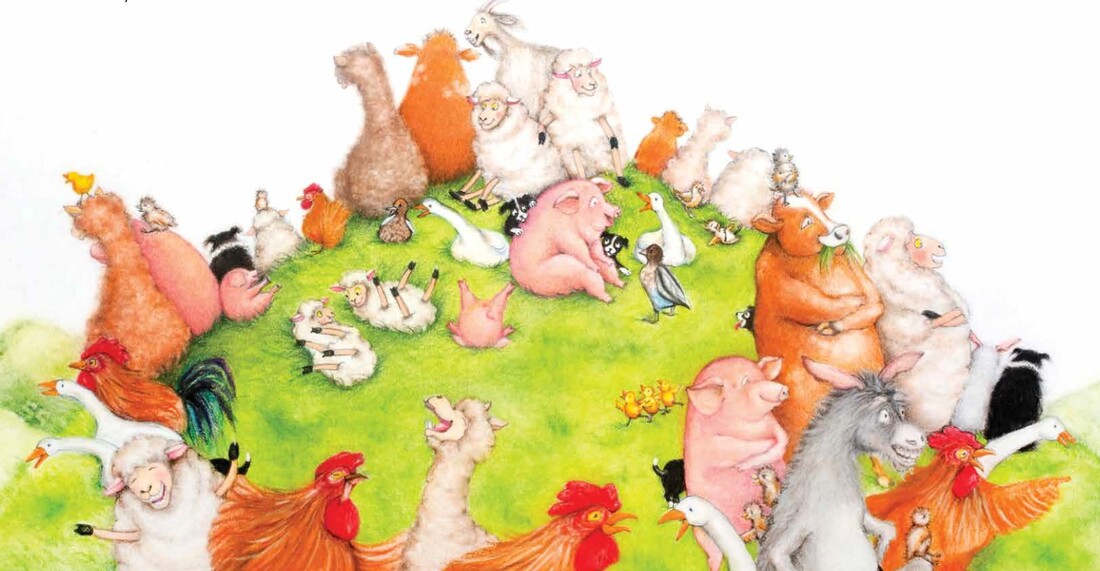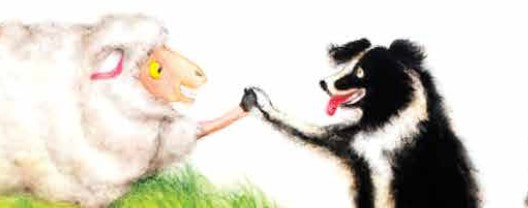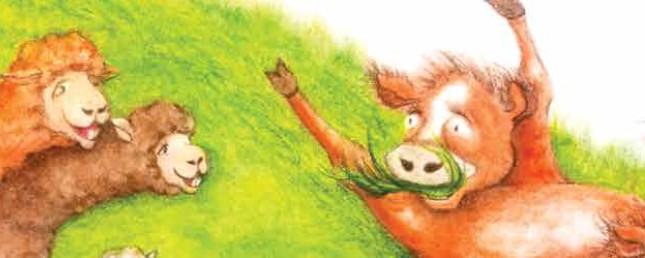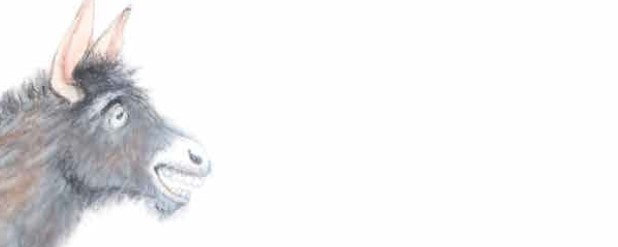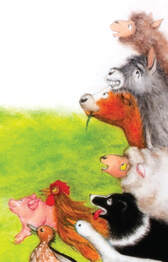ONE AT A TIME - Extended Learning Activities
written by Cate Ellis
Numeracy
To be used alongside the book ONE AT A TIME by CATE ELLIS (available here)
GOING UP THE HILL - ADDITION
|
Turn the page:
How many cow’s tails are there? Note - there are 3 cows and only two tails are showing, therefore one must be hidden. [ 2 + 1 = 3 ] How many alpaca’s tails are there? Note - There are 4 alpacas and only 2 tails are showing, therefore 2 must be hidden. [ 2 + 2 = 4 ]. How many tails would there be if you could see them altogether? [ 3 + 4 = 7 ] |
|
Turn the page:
What does 2 large dogs and 5 puppies equal? [ 2 + 5 = 7 ]. What does 6 large sheep and 2 lambs equal? [ 6 + 2 = 8 ]. How many large dogs are there and how many large sheep? [ 2 + 6 = 8 ]. How many puppies are there and how many lambs? [ 5 + 2 = 7 ] If you add these altogether you will know how many animals are on this double page. [ 8 + 7 = 15 ] or [ 7 + 8 = 15 ]. |
|
Turn the page:
All the animals are together, making it hard to count them. How could you find out how many there are altogether? A tricky Challenge! E.g., [1+2+3+4+5+6+7+8+9+10=55] or [1+2+3+4+5=15], [6+7+8+9+10=30], [15+30=55] Find the number hidden in the grass to check your answer! Did you find all the animals on the hill? 1 goat, 2 donkeys, 3 cows, 4 alpacas, 5 pigs, 6 geese, 7 dogs, 8 sheep, 9 chickens, 10 ducks. |
GOING DOWN THE HILL - SUBTRACTION
|
Turn the page:
There are 8 ducklings on the page. How many are dancing on the ground? Note - 1 is standing on a head, so that means 8 minus 1 are dancing on the ground. [ 8 – 1 = 7 ]. 7 are dancing on the ground. There are 4 chicks but only 3 are dancing. How many are not dancing? [ 4 – 3 = 1 ]. 1 is not dancing. |
|
Turn the page:
There are 8 sheep altogether on the page. How many are rolling? Note - 2 sheep are walking, so that means 8 minus 2 are rolling, [ 8 – 2 = 6 ]. 6 sheep are rolling. There are 7 dogs on the page. How many are sitting and standing? Note - only 1 dog is not sitting or standing. So there are 7 dogs minus 1 not sitting or standing on the hill [7 – 1 = 6 ]. |
|
Turn the page:
There are 6 geese and only 1 is waving its wing. How many are not waving their wings? Note - 6 minus 1 are not waving their wings, [ 6 -1 = 5 ]. So there are 5 geese not waving their wings. There are 5 pigs altogether, but only 3 are large. How many are small? Note - 5 pigs minus 3 equals 2, [ 5 – 3 = 2 ]. 2 pigs are small. |
GOING DOWN THE HILL - MULTIPLICATION
Turn to the page with ducks and chickens going down the hill:
There are 8 ducklings and they each have 1 beak. How many duckling beaks are there altogether?
You have 1 beak 8 times, [ 1 x 8 = 8 ].
There are 4 chicks and they each have 2 legs. How many chick’s legs are there altogether?
You have 2 legs 4 times, [ 2 x 4 = 8 ].
There are 8 ducklings and they each have 1 beak. How many duckling beaks are there altogether?
You have 1 beak 8 times, [ 1 x 8 = 8 ].
There are 4 chicks and they each have 2 legs. How many chick’s legs are there altogether?
You have 2 legs 4 times, [ 2 x 4 = 8 ].
Turn the page:
There are 8 sheep with 4 legs each. How many sheep’s legs are there altogether?
You have 4 legs 8 times. That is a lot of legs! [ 4 x 8 = 32 ]. You can also write this as [ 8 x 4 = 32 ].
There are 7 dogs and they each have 2 ears. How many does that make altogether?
You have 2 ears 7 times. That makes 14 ears, [ 2 x 7 = 14 ]. You can also write this as [ 7 x 2 = 14 ].
There are 8 sheep with 4 legs each. How many sheep’s legs are there altogether?
You have 4 legs 8 times. That is a lot of legs! [ 4 x 8 = 32 ]. You can also write this as [ 8 x 4 = 32 ].
There are 7 dogs and they each have 2 ears. How many does that make altogether?
You have 2 ears 7 times. That makes 14 ears, [ 2 x 7 = 14 ]. You can also write this as [ 7 x 2 = 14 ].
Turn the page:
Geese have 2 legs each. In this picture you can only see 6 legs, even though there are 6 geese. If you could see them all, how many would there be?
[ 6 x 2 = 12 ]. There would be 12 legs.
Challenge: How many can’t you see?
[12 – 6 = 6 ].
There are 5 pigs with 2 ears each. How many pig’s ears are there altogether?
5 times 2 equals 10, [ 5 x 2 = 10 ]. There are 10 ears.
Geese have 2 legs each. In this picture you can only see 6 legs, even though there are 6 geese. If you could see them all, how many would there be?
[ 6 x 2 = 12 ]. There would be 12 legs.
Challenge: How many can’t you see?
[12 – 6 = 6 ].
There are 5 pigs with 2 ears each. How many pig’s ears are there altogether?
5 times 2 equals 10, [ 5 x 2 = 10 ]. There are 10 ears.
Turn the page:
Each animal on this double page has 2 eyes. There are 7 animals altogether, so how many eyes are there in total?
Note - If you start with the number of animals, that means 7 times 2 equals 14.
The animals have14 eyes in total. [ 7 x 2 = 14 ].
Challenge: Is that the same as 2 times 7 equals 14?
[2 x 7 = 14 ]?
Each animal on this double page has 2 eyes. There are 7 animals altogether, so how many eyes are there in total?
Note - If you start with the number of animals, that means 7 times 2 equals 14.
The animals have14 eyes in total. [ 7 x 2 = 14 ].
Challenge: Is that the same as 2 times 7 equals 14?
[2 x 7 = 14 ]?
Turn the page:
Each donkey has 4 legs, even if we can’t see them all.
How many legs are there altogether?
Note - There are 4 legs on each Donkey, so 4 times 2 equals 8, [ 4 x 2 = 8 ]. There are 8 legs in total.
Each donkey has 4 legs, even if we can’t see them all.
How many legs are there altogether?
Note - There are 4 legs on each Donkey, so 4 times 2 equals 8, [ 4 x 2 = 8 ]. There are 8 legs in total.
Turn the page:
Here is just 1 goat. Can you think of some addition, subtraction or multiplication you can do with this picture?
E.g., 1 goat plus zero goats equals 1 goat [ 1 + 0 = 1 ];
4 hooves minus 2 hooves equals 2 hooves visible [ 4 – 2 = 2 ];
1 leg times 4 equals 4 legs, [ 1 x 4 = 4 ].
Can you think of other additions, subtractions and multiplications with the animals going up the hill as well?
Here is just 1 goat. Can you think of some addition, subtraction or multiplication you can do with this picture?
E.g., 1 goat plus zero goats equals 1 goat [ 1 + 0 = 1 ];
4 hooves minus 2 hooves equals 2 hooves visible [ 4 – 2 = 2 ];
1 leg times 4 equals 4 legs, [ 1 x 4 = 4 ].
Can you think of other additions, subtractions and multiplications with the animals going up the hill as well?

